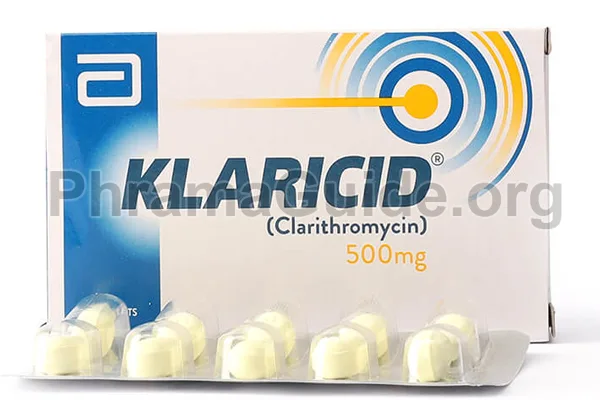Klaricid is an antibiotic medication commonly used to treat various bacterial infections. Like all antibiotics, it can have side effects. The side effects of Klaricid can range from common and mild to less common and potentially serious. Here are some of the common and less common side effects associated with Klaricid.
Common Side Effects:
- Gastrointestinal Disturbances: Gastrointestinal symptoms are the most common side effects and may include nausea, vomiting, diarrhea, abdominal pain, and changes in taste. Taking the medication with food can help reduce these symptoms.
- Headache: Some individuals may experience mild to moderate headaches while taking Klaricid.
- Rash: Skin rashes, including itching and hives, can occur in some patients.
- Dysgeusia: This refers to a change in taste, which can include a metallic or bitter taste in the mouth.
- Nervous System Effects: Mild dizziness and altered sense of taste or smell can occur in some cases.
Less Common Side Effects:
- Allergic Reactions: Although less common, severe allergic reactions can happen. Symptoms may include swelling of the face, lips, tongue, or throat, difficulty breathing, and hives. Seek immediate medical attention if you experience these symptoms.
- Liver Problems: Rarely, Klaricid can cause liver problems, such as elevated liver enzymes. Symptoms may include jaundice (yellowing of the skin and eyes) or dark urine.
- Clostridium difficile-associated Diarrhea (CDAD): Prolonged use of Klaricid can lead to the overgrowth of a bacteria called Clostridium difficile, causing severe diarrhea and colitis. If you experience persistent diarrhea while taking Klaricid, contact your healthcare provider.
- Hearing Loss or Tinnitus: Though rare, some cases of hearing loss or ringing in the ears (tinnitus) have been reported with Klaricid use.
- Cardiac Arrhythmias: Klaricid may affect the electrical activity of the heart, potentially leading to heart rhythm abnormalities, particularly in individuals with pre-existing heart conditions. It is important to inform your healthcare provider of any existing heart conditions.
- Psychiatric Effects: In rare instances, psychiatric side effects, including anxiety, hallucinations, and confusion, have been reported.
- Blood Disorders: Extremely rare cases of blood disorders like thrombocytopenia (low platelet count) have been associated with Klaricid use.

What is Klaricid?
Klaricid is one of the leading brands of Clarithromycin, manufactured and marketed by Abbott Laboratories.
Klaricid : Available Formulations and Strengths
Presently, Klaricid is available in Tablet, Syrup, and Injection forms.
Klaricid Tablets : 250mg, and 500mg strengths.
Klaricid XL Tablet : 500mg strength.
Klaricid Syrup : 125mg/5ml strength.
Klaricid IV Injection : 500/vial (10ml) strength.
.
What Are The Possible Drug Interactions of Klaricid?
- Warfarin: Klaricid may increase the anticoagulant effect of warfarin, which can lead to an increased risk of bleeding. Frequent monitoring of the International Normalized Ratio (INR) is necessary when these medications are used together.
- Statins (HMG-CoA reductase inhibitors): Combining Klaricid with statins like atorvastatin, simvastatin, or lovastatin can raise the risk of muscle toxicity, potentially leading to a rare but severe condition called rhabdomyolysis. It’s advisable to avoid this combination or use an alternative antibiotic if possible. If combined, lower statin doses may be necessary.
- Calcium Channel Blockers: Klaricid can increase the blood levels of calcium channel blockers like amlodipine, verapamil, and diltiazem, potentially leading to an increased risk of side effects, including heart rhythm disturbances and low blood pressure. Dose adjustments may be needed.
- Digoxin: Klaricid can increase the blood levels of digoxin, a medication used for heart conditions. This can lead to digoxin toxicity, which may manifest as symptoms like nausea, vomiting, and heart rhythm abnormalities.
- Carbamazepine: Klaricid can raise the blood levels of carbamazepine, an antiepileptic drug, potentially increasing the risk of side effects.
- Theophylline: Co-administration of Klaricid and theophylline can lead to increased theophylline levels in the blood, which may result in theophylline toxicity. Monitoring and dosage adjustments are necessary when using these drugs together.
- Anticoagulants and Antiplatelet Drugs: Klaricid can increase the risk of bleeding when combined with other anticoagulant and antiplatelet medications.
- Triazolam and Midazolam: Klaricid can enhance the sedative effects of these drugs, which are used as sleep aids or for pre-surgery sedation. Lower doses of these medications may be required when used with Klaricid.
- Antacids: Concurrent use of antacids may reduce the absorption of Klaricid. To maximize its effectiveness, it’s generally advised to separate the administration of antacids and Klaricid by a few hours.
- Oral Contraceptives: Klaricid may reduce the effectiveness of oral contraceptives. Alternative or additional contraceptive methods may be needed during antibiotic treatment.

Leave A Comment